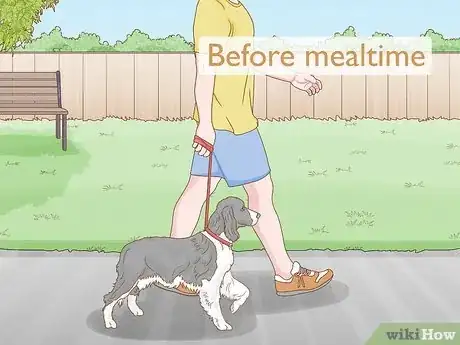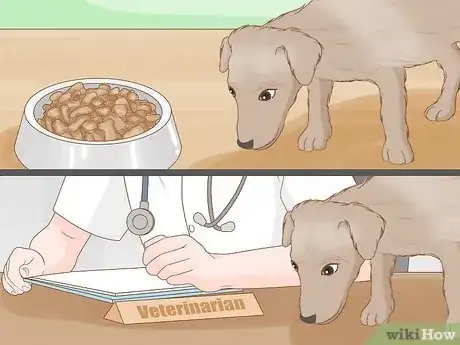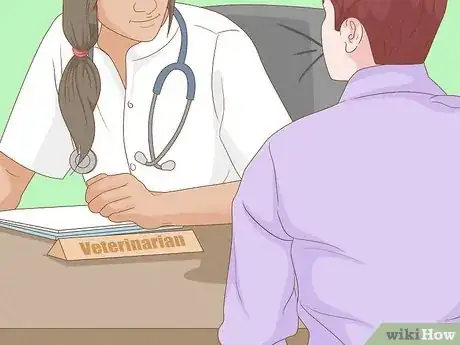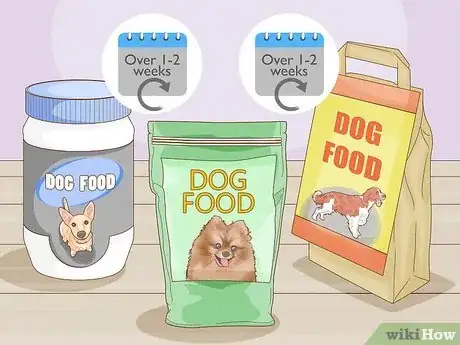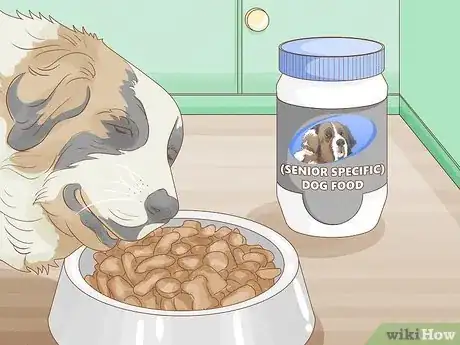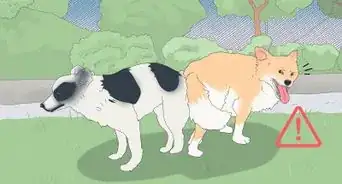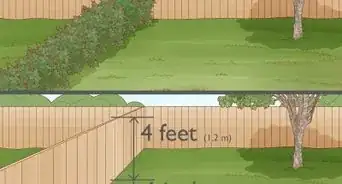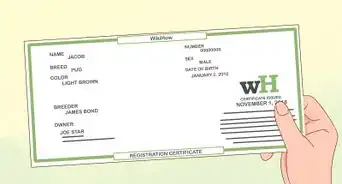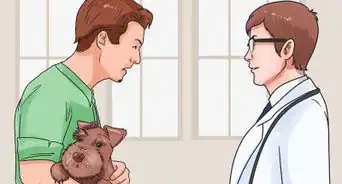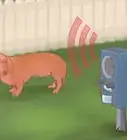This article was co-authored by Brian Bourquin, DVM and by wikiHow staff writer, Christopher M. Osborne, PhD. Brian Bourquin, better known as “Dr. B” to his clients, is a Veterinarian and the Owner of Boston Veterinary Clinic, a pet health care and veterinary clinic with three locations, South End/Bay Village, the Seaport, and Brookline, Massachusetts. Boston Veterinary Clinic specializes in primary veterinary care, including wellness and preventative care, sick and emergency care, soft-tissue surgery, dentistry. The clinic also provides specialty services in behavior, nutrition, and alternative pain management therapies using acupuncture, and therapeutic laser treatments. Boston Veterinary Clinic is an AAHA (American Animal Hospital Association) accredited hospital and Boston’s first Fear Free Certified Clinic. Brian has over 19 years of veterinary experience and earned his Doctor of Veterinary Medicine from Cornell University.
This article has been viewed 27,025 times.
Most dogs can go at least 2-3 days without eating and not suffer any negative health impacts, but it can still be frustrating and worrisome if your dog refuses to eat. In some cases, health issues are to blame and you should definitely involve your veterinarian in finding solutions. When illness isn’t the cause, creating a more comfortable eating environment based on the dog’s personality will often help. And, for some picky eaters, a “tough love” approach of putting a single food out for a set amount of time will convince them to eat.
Steps
Making Mealtime Comfortable
-
1Create a feeding environment that suits their personality. If you have an anxious or reserved dog, they may not be comfortable eating near other animals or even people. However, highly active or sociable dogs might despise being fed in a quiet, isolated location. So, try switching up where you feed your dog to see if it makes them more eager to eat.[1]
- For an anxious dog, see if feeding them in a quiet corner of your kitchen helps them to remain calm and focused on their meal.
- For a very active dog, try incorporating games into mealtime or using a food-dispensing toy that makes them work (or more accurately, play) for their meal.
-
2Feed them in a cooler location if you think they may be too warm. Dogs, like people, tend to have a reduced appetite when they’re sweltering. See if moving your dog’s feeding spot to a cooler and comfier spot helps to spur their desire to eat.[2]
- Instead of feeding them near a sunny window, for instance, move their feeding spot to a cooler corner of the room. If you can increase the air circulation with a ceiling fan or open window, that may help even more.
- If your dog is eating outdoors, make sure you provide them with a shady, breezy location.
Advertisement -
3Raise, lower, or switch out their feeding dishes to suit the dog’s size. It can be uncomfortable for a short dog to eat from a large bowl, or a tall dog to eat from a small bowl. Switching to a bowl that better suits your dog’s size will make it easier for them to actually get to their food.[3]
- Most dogs prefer to eat with their head dipped down while standing straight. If they have to crouch, lie down or crane their neck upward, they may be uncomfortable.
- Use metal or ceramic feeding bowls if possible. Plastic bowls tend to crack and chip, which can result in pieces of plastic mixing in with the dog’s food.
-
4Walk together before mealtime to spur their appetite. For energetic dogs, a nice walk might help to calm them down a bit so they’re more focused on eating. Getting some exercise might also simply make them hungrier. For older dogs, walking might make them less lethargic and give them a shot of energy for eating.[4]
- Some dogs, however, might get either too revved up or too worn out from a walk before mealtime. In this case, it may be better to walk with them after they eat.
-
5Be consistent with the routine that works best. Many dogs are perfectly content to eat the exact same meal at the exact same time in the exact same place every day. Your goal, therefore, should be to find the particular eating routine that works best for your specific dog, and then stick to it consistently.[5]
- Unfamiliar settings or other changes in routine—such as going on a trip or moving to a new home—often lead to appetite issues for dogs. Expect this to happen and do your best to establish a new or temporary routine for them.
- It’s possible that a dog might get bored with a certain food or certain routine and need a switch to spur their appetite, and in that case, you should try making adjustments. But you’ll often find that once you find that “Goldilocks” (just right) eating routine for your dog, they’ll want to stick with it permanently.
Helping a Sick Dog
-
1Get a vet’s diagnosis after 1-2 days of not eating. Some dogs may go through phases where they don’t eat much or at all for 2-3 days, and this typically isn’t a health concern. However, once your dog makes it into a second full day without eating, it’s a good idea to contact your vet and see if they recommend a visit. This is especially true if your dog shows any potential signs of illness, such as lethargy, weakness, pain, vomiting, diarrhea, etc.[6]
- Always call the vet if your dog makes it into a third full day without eating, even if the dog shows no signs of illness.
- Loss of appetite in dogs (known as canine anorexia) can be caused by a range of illnesses, including cancer, infections, liver or kidney diseases, dental problems, and others.
- Try and get as many clues as possible as to what might be wrong. Follow the dog out into the yard to see if they have an upset tummy or not. Be vigilant for signs such as increased thirst, lack of energy, coughing, or sneezing. Giving the vet the full picture in this way will help them reach a diagnosis.
-
2Feed them a prescription diet if recommended. If the vet diagnoses your dog with a particular illness that is causing a lack of appetite, they may recommend a specific prescription diet. This diet will help to ensure that your dog is getting the necessary nutrients, even if they aren’t eating as much.[7]
- The prescription diet will typically be a specially formulated dog food that you may be able to get from your vet directly or from pet supply stores.
- The vet may recommend that you mix some of the prescription dog food with the dog’s regular food in order to get them to eat it.
- Let the vet know if your dog refuses to eat the prescription diet.
-
3Ask if appetite-stimulating medications should be used. In some cases, it may be advisable to give your dog medication to spur their appetite. Your vet will make this determination based on their illness, their overall health, and other factors.[8]
- Make sure the vet tells you exactly how and how often to give the medication—ask them to demonstrate the process if possible. It may be given by oral syringe or in pill form.
- Also make sure you know what side effects to watch for and whether you need to contact the vet if you recognize any of them.
-
4Use syringe-feeding or a feeding tube if necessary. If your dog absolutely refuses to eat on their own, you may have to resort to feeding liquids or liquefied foods by oral syringe. Work with your vet to determine the best diet to provide via syringe, and have them show you how to effectively feed your dog this way.[9]
- Most dogs won’t be eager to eat this way, so you’ll have to show a lot of compassion and support and give them lots of praise during and after feedings.
- As a last resort, your dog may have to be connected to a feeding tube in order to get nutrients. This will usually occur only in an animal hospital or similar facility, however.
Changing Foods for Picky Eaters
-
1Make sure their food hasn’t gone bad if they won’t eat it. If your dog stops eating a food they typically gobble up, give it a smell and check the date on the package. Dry foods may start to go rancid.[10] Wet foods will start to go bad (once opened) after about 3 days in the refrigerator.[11]
- Take a good whiff of their dog food when it’s fresh to get an idea of what it should smell like, then use this as your basis of comparison to know when it has gone bad.
-
2Mix in about 10% table food or cat food to add interest to their regular food. Sometimes it may help to “spice up” your dog’s regular routine without actually changing foods. Try mixing a little bit of cooked egg, boneless chicken, or other table food that they like into their regular food. Or, try stirring in some cat food—some dogs really like it![12]
- Blend the added food in well so that they can’t just pick out the add-ins and skip their regular food. The added food should make up no more than about 10% of the total food amount.
- It’s fine to do this every day if it succeeds in getting your dog to eat.
- Never give dogs table foods with bones—which are a choking hazard—or other indigestible components.
-
3Switch foods over 1-2 weeks to see if they’ll eat another brand/type. If you decide to switch your dog from one brand or type of food to another, don’t make the switch in a single day. Instead, gradually mix the new food into the old one over the span of several days to help ease the transition. This prevents an abrupt change in routine, and may also prevent gastrointestinal issues that can crop up when a dog’s diet changes.[13]
- For instance, you might give them 90% old food and 10% new food on Day 1 and keep adding 10% to the new food amount (and reducing the old food amount by the same) over the following 9 days.
- If your dog experiences vomiting or diarrhea during the transition, contact your vet for advice.
-
4Use senior-specific foods for older dogs. Older dogs often become less interested in eating, so they may need extra encouragement through things like ample praise and pre-meal walks. Often, though, it’s the decline in their sense of smell that makes them less eager to eat foods that now seem bland. Foods marketed for older dogs tend to have stronger scent and flavor profiles to help make up for a reduced sense of smell.[14]
- Senior-specific dog foods also have nutritional profiles that are better suited to older dogs.
- Contact your vet for dog food recommendations for your older dog.
Using “Tough Love” on Picky Eaters
-
1Give the dog only 1 food option to simplify the choice. If you find yourself frustrated because you have to put out multiple types of dog food out each time in the hopes your canine pal will pick one to eat, you may benefit from a simpler approach. Pick a single, nutritious, age- and breed-appropriate dog food, and put the recommended amount in the dog dish at mealtime. Don’t offer any alternatives, or make it seem that alternatives are even possible.[15]
- At first, your dog may resist this new approach, and may refuse to eat. But stick with it.
- This “tough love” approach may work better on some dogs than others, and may not be suited to all owners. Get your vet’s opinion on whether this seems like a good approach for your situation.
-
2Leave the room while the dog eats. If you stay in the room the dog will pick up your anxiety over their appetite. Instead, leave the room for 10 minutes. When you come back in ignore the dog if he hasn't eaten, but praise him if he has.
- Avoid hand feeding or fussing over the dog.
-
3Remove the food after 30 minutes each mealtime. Whether they eat two-thirds of the food or only 2 bites of it, take away the food dish after half an hour. Don’t offer any other food or treats. Teach your dog that mealtime lasts 30 minutes, and the food in their bowl is their only option.[16]
- 30 minutes is a good starting point, but you might use 20-minute or 40-minute limits based on your dog’s eating habits. The key is to be consistent with the timing every day.
- After a few days, most dogs will get the message and will eat their fill within the 30 minutes.
- If they consistently eat two-thirds of the food for a week or 2, you can reduce how much you give them to that amount. So long as they’re maintaining a healthy weight, that’s likely the right amount of food for them.
-
4Cut out table scraps and excessive treats between meals. Designate mealtime as the time for eating, and the rest of the day as a time for other activities, like play, exercise, rest, and so on. Give treats sparingly, only as immediate rewards for specified good behavior or when training.[17]
- This will further motivate the dog to eat their food at mealtime in a timely manner.
- If this “tough love” approach isn’t working for you, or if your dog is losing too much weight or seems less healthy overall, get in touch with your vet for guidance.
- Keep in mind that treats are more filling for small dogs.[18]
Warnings
- If your dog isn't eating, it's always a good idea to get them checked out by a veterinarian in case there's an underlying health issue to blame.[19]⧼thumbs_response⧽
References
- ↑ https://pets.webmd.com/dogs/guide/dog-not-eating-possible-causes-and-appetite-solutions#1
- ↑ https://www.petmd.com/dog/nutrition/evr_dg_why-wont-my-dog-eat-his-dog-food
- ↑ https://pets.webmd.com/dogs/guide/dog-not-eating-possible-causes-and-appetite-solutions#1
- ↑ https://pets.webmd.com/dogs/guide/dog-not-eating-possible-causes-and-appetite-solutions#1
- ↑ https://pets.webmd.com/dogs/guide/dog-not-eating-possible-causes-and-appetite-solutions#1
- ↑ https://www.petmd.com/dog/nutrition/evr_dg_why-wont-my-dog-eat-his-dog-food
- ↑ https://pets.webmd.com/dogs/guide/dog-not-eating-possible-causes-and-appetite-solutions#1
- ↑ https://pets.webmd.com/dogs/guide/dog-not-eating-possible-causes-and-appetite-solutions#1
- ↑ https://pets.webmd.com/dogs/guide/dog-not-eating-possible-causes-and-appetite-solutions#1
- ↑ Brian Bourquin, DVM. Veterinarian. Expert Interview. 20 December 2019.
- ↑ https://www.petmd.com/dog/nutrition/evr_dg_why-wont-my-dog-eat-his-dog-food
- ↑ https://www.petmd.com/dog/nutrition/evr_dg_why-wont-my-dog-eat-his-dog-food
- ↑ https://www.petmd.com/dog/nutrition/evr_dg_why-wont-my-dog-eat-his-dog-food
- ↑ https://www.petmd.com/dog/nutrition/evr_dg_why-wont-my-dog-eat-his-dog-food
- ↑ https://www.petmd.com/dog/nutrition/evr_dg_why-wont-my-dog-eat-his-dog-food
- ↑ https://www.petmd.com/dog/nutrition/evr_dg_why-wont-my-dog-eat-his-dog-food
- ↑ https://www.petmd.com/dog/nutrition/evr_dg_why-wont-my-dog-eat-his-dog-food
- ↑ Brian Bourquin, DVM. Veterinarian. Expert Interview. 20 December 2019.
- ↑ Brian Bourquin, DVM. Veterinarian. Expert Interview. 20 December 2019.



